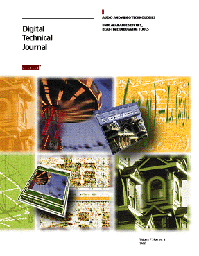 Jane C. Blake,
Jane C. Blake,
Managing Editor
This issue's opening section features audio and video
technologies that exploit the power of Digital's 64-bit RISC
Alpha systems. Papers describe new software and hardware designs
that make practical such applications as text-to-speech
conversion and full-motion video on the desktop. A second set of
papers shifts the focus to the UNIX environment with discussions
of high-availability services and of Encore Computer
Corporation's new real-time debugging tool.
The opening paper for the audio and video section references an
audio technology that physicist Stephen Hawking uses to convert
the text he types to highly intelligible synthetic speech.
Recently, engineers have ported this mature 10-year-old hardware
technology, called DECtalk, to text-to-speech software. Bill
Hallahan explains that the computational power of Digital's Alpha
systems now makes it possible for a software speech synthesizer
to simultaneously convert many text streams to speech without
overloading a workstation. After reviewing relevant speech
terminology and popular synthesis techniques, he describes
DECtalk Software multithreaded processing and the new
text-to-speech application programming interface for UNIX and NT
workstations.
Video technologies -- full-motion video on workstations -- also
capitalize on the high performance of Alpha systems. In the first
of four papers focused on digital video, Ken Correll and Bob
Ulichney present the J300 video and audio adapter architecture.
To improve on past full-motion video implementations, designers
sought to allow video data to be treated the same as any other
data type in a workstation. The authors review the J300 features,
including a versatile color-map rendering system, and the
subsystem design decisions made to keep product costs low.
Victor Bahl then presents the J300 software that controls the
hardware. The challenge for software designers was to obtain
real-time performance from a non-real-time operating system. A
description of the video subsystem highlights the video library
and an innovative use of queues in achieving good performance.
This software architecture has been implemented on OpenVMS,
Window NT, and Digital UNIX platforms.
A third paper on video technology looks at delivering video
without specialized hardware, that is, a software-only
architecture for general-purpose computers that provides access
to video codecs and renderers through a flexible application
programming interface. Again, faster processors make a
software-only solution possible at low cost. Authors Victor Bahl,
Paul Gauthier, and Bob Ulichney preface the paper with an
overview of industry-standard codecs and compression schemes.
They then discuss the creation of the software video library, its
architecture, and its implementation of video rendering that
parallels the J300 hardware implementation.
The final paper in the audio and video technologies section
explicitly raises the question of what features are best
implemented in hardware and what in software. The context for the
question is a graphics accelerator chip design that integrates
traditional synthetic graphics features and video image display
features -- until now, implemented separately. Larry Seiler and
Bob Ulichney describe the video processing implemented
differently in two chips, both of which offer significantly
higher performance with minimal additional logic.
The common theme of our second section is the UNIX operating
system. Larry Cohen and John Williams present the DECsafe
Available Server Environment (ASE), which provides high
availability for applications running on Digital UNIX systems.
They describe the ASE design for detection and dynamic
reconfiguration around host, storage device, and network
failures, and review key design trade-offs that favored software
reliability and data integrity.
Mike Palmer and Jeff Russo then contrast Encore Computer
Corporation's set of debug and analysis tools for real-time
applications, called Parasight, with conventional UNIX tools.
They examine the features that are critical in an effective
real-time debugging tool, for example, the ability to attach to a
running program and to analyze several programs simultaneously. A
description follows of the Parasight product, which includes the
features necessary for real-time debug and analysis in a set of
graphical user interface tools.
Upcoming in our next issue are papers on a variety of topics,
including Digital UNIX clusters, eXcursion for NT, and network
services.
|